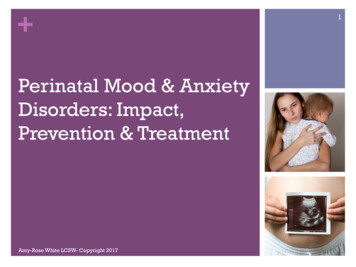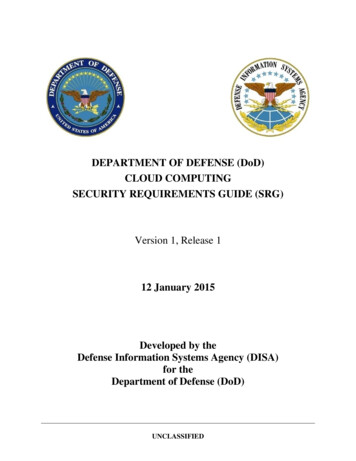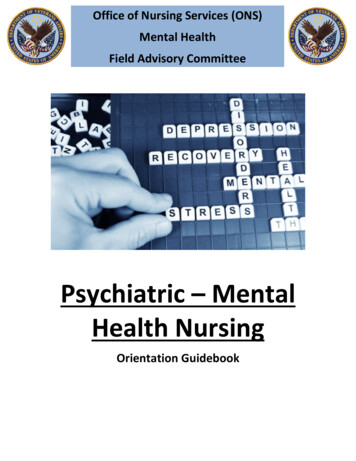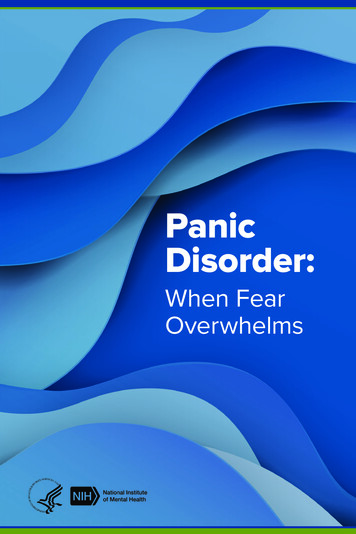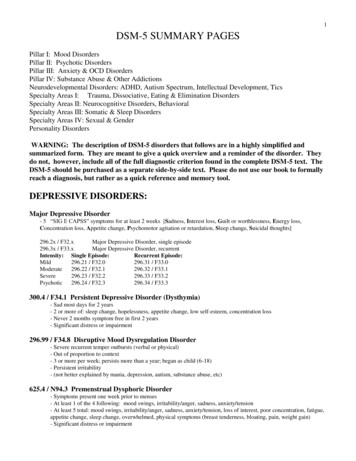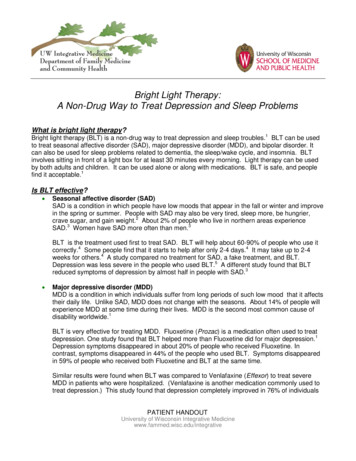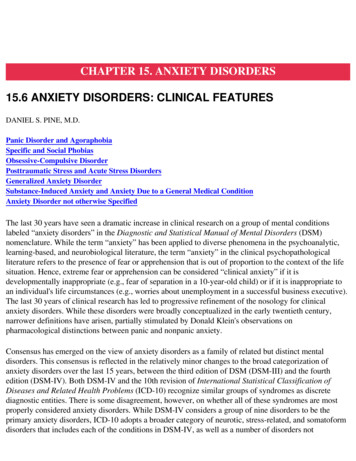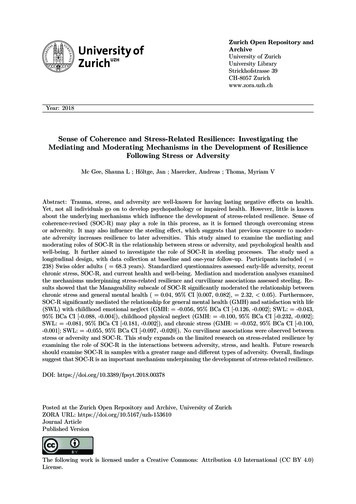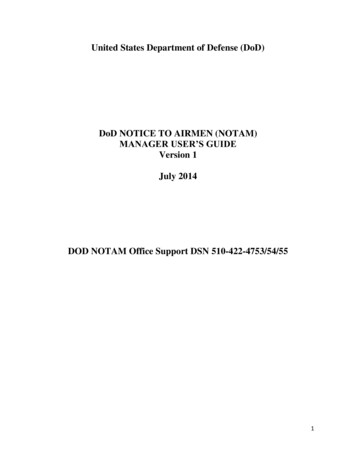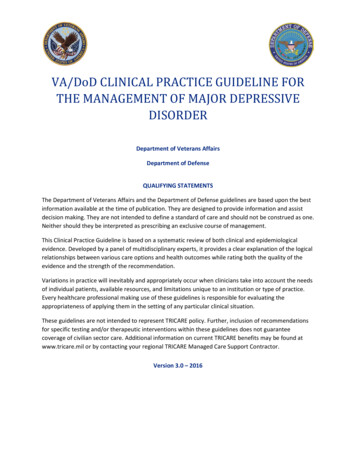
Transcription
VA/DoD CLINICAL PRACTICE GUIDELINE FORTHE MANAGEMENT OF MAJOR DEPRESSIVEDISORDERDepartment of Veterans AffairsDepartment of DefenseQUALIFYING STATEMENTSThe Department of Veterans Affairs and the Department of Defense guidelines are based upon the bestinformation available at the time of publication. They are designed to provide information and assistdecision making. They are not intended to define a standard of care and should not be construed as one.Neither should they be interpreted as prescribing an exclusive course of management.This Clinical Practice Guideline is based on a systematic review of both clinical and epidemiologicalevidence. Developed by a panel of multidisciplinary experts, it provides a clear explanation of the logicalrelationships between various care options and health outcomes while rating both the quality of theevidence and the strength of the recommendation.Variations in practice will inevitably and appropriately occur when clinicians take into account the needsof individual patients, available resources, and limitations unique to an institution or type of practice.Every healthcare professional making use of these guidelines is responsible for evaluating theappropriateness of applying them in the setting of any particular clinical situation.These guidelines are not intended to represent TRICARE policy. Further, inclusion of recommendationsfor specific testing and/or therapeutic interventions within these guidelines does not guaranteecoverage of civilian sector care. Additional information on current TRICARE benefits may be found atwww.tricare.mil or by contacting your regional TRICARE Managed Care Support Contractor.Version 3.0 – 2016
VA/DoD Clinical Practice Guideline for the Management of Major Depressive DisorderPrepared by:The Management of Major Depressive DisorderWorking GroupWith support from:The Office of Quality, Safety and Value, VA, Washington, DC&Office of Evidence Based Practice, U.S. Army Medical CommandVersion 3.0 – 2016Based on evidence reviewed through January 2015April 2016Page 2 of 173
VA/DoD Clinical Practice Guideline for the Management of Major Depressive DisorderTable of ContentsI.Introduction .5II.Background .5A.B.III.Depression in the General Population. 6C.Depression in the VA/DoD Populations . 6A.Target Population . 7Scope of the Guideline.7B.C.IV.Major Depressive Disorder . 5Audiences . 7Outcomes of Interest . 7D.Goals of the Guideline . 7A.Methods. 8About this Clinical Practice Guideline .8B.Conflict of Interest . 11E.Knowledge Gaps and Future Directions . 12C.Highlighted Features of this CPG . 11Implementation . 13V.F.VI.Algorithm . 15VII.Recommendations . 17D.Patient-centered Care . 12Guideline Working Group . 14A.B.C.D.Identification. 21Assessment and Triage . 22Treatment Setting . 26Management . 28E.Other Treatment Considerations. 43A.Developing the Scope and Key Questions . 59Appendix A: Evidence Review Methodology . 59B.Conducting the Systematic Review . 60E.Recommendation Categorization . 85C.D.April 2016The Face-to-Face Meeting . 82Grading Recommendations . 82Page 3 of 173
VA/DoD Clinical Practice Guideline for the Management of Major Depressive DisorderF.Drafting and Submitting the Final Clinical Practice Guideline . 87A.Purpose . 89Appendix B: Quick Guide to the Patient Health Questionnaire (PHQ). 89B.Scoring the PHQ-9. 89Appendix C: Pharmacotherapy . 93Appendix D: Definitions . 100A.B.Major Depressive Disorder . 100Treatments . 102Appendix E: Evidence Table . 104Appendix F: 2009 Recommendation Categorization . 110Appendix G: Participant List . 158Appendix H: Abbreviation List . 160References. 163April 2016Page 4 of 173
VA/DoD Clinical Practice Guideline for the Management of Major Depressive DisorderI.IntroductionThe Department of Veterans Affairs (VA) and the Department of Defense (DoD) Evidence-Based PracticeWorking Group (EBPWG) were established and first chartered in 2004, with a mission to advise the“ Health Executive Council on the use of clinical and epidemiological evidence to improve the health ofthe population across the Veterans Health Administration (VHA) and Military Health System,” byfacilitating the development of clinical practice guidelines (CPG) for the VA and DoD populations.[2] ThisCPG is intended to provide primary care clinicians with a framework by which to evaluate, treat, andmanage the individual needs and preferences of patients with major depressive disorder (MDD), therebyleading to improved clinical outcomes.In 2009, the VA and DoD published a CPG for the Management of Major Depressive Disorder (2009 MDDCPG), which was based on evidence reviewed through 2007. Since the release of that guideline, agrowing body of research has expanded the general knowledge and understanding of MDD and itsmanagement. Recognition of the complex nature of this condition has led to the adoption of newstrategies to manage and treat patients with MDD, including new developments related topharmacotherapy and other treatment options.Consequently, a recommendation to update the 2009 MDD CPG was implemented in 2014. The updatedCPG includes objective, evidence-based information on the management of MDD. It also broughtdiagnostic criteria for MDD in congruence with the Diagnostic and Statistical Manual of MentalDisorders, fifth edition (DSM-5). It is intended to assist healthcare providers in all aspects of patient careincluding, but not limited to, diagnosis, treatment, and follow-up. The system-wide goal of evidencebased guidelines is to improve the patient’s health and wellbeing by guiding health providers who aretaking care of patients with MDD along the management pathways that are supported by evidence. Theexpected outcomes of successful implementation of this guideline are to improve how providers: Assess the patient’s condition and determine the best treatment method Optimize the use of therapy to improve symptoms and functioning, treatment of the condition’sacute phase, prevent relapse, and improve both health and quality of life outcomes Minimize preventable complications and morbidity Emphasize the use of patient-centered careII.BackgroundA.Major Depressive DisorderDepression is a common mental disorder that presents with depressed mood, loss of interest orpleasure in regular activities, decreased energy, feelings of guilt or low self-worth, disturbed sleep orappetite, and poor concentration. Major depressive disorder is the most prevalent and disabling form ofdepression. In addition to the immediate symptoms of depression, MDD results in poor quality of lifeoverall, decreased productivity, and can increase mortality from suicide. Social difficulties includingstigma, loss of employment, and marital conflict as a result of depression can also occur. Anxiety,April 2016Page 5 of 173
VA/DoD Clinical Practice Guideline for the Management of Major Depressive Disorderposttraumatic stress disorder (PTSD), and substance misuse are common co-occurring conditions thatmay worsen the existing depression and complicate treatment.Depression is considered to be a largely biological illness but can result from a combination of genetic,biological, environmental, and psychological factors. Trauma, loss of a loved one, a difficult relationship, orany stressful situation may trigger depression, but depression can also occur without an obvious trigger.B.Depression in the General PopulationAccording to the National Alliance on Mental Illness, an estimated 16 million American adults—almost7% of the population—had at least one major depressive episode in the past year. Women are 70%more likely than men to experience depression, and young adults aged 18–25 are 60% more likely tohave depression than people aged 50 or older.[3] Depressive disorders often start at a young age; theyreduce people’s functioning and often recur.[4] According to the World Health Organization (WHO),MDD (identified as unipolar depressive disorders by WHO) ranked first worldwide among the leadingcauses of disability (i.e., aggregate years lived with disability [YLD]).[5]The incremental economic burden of individuals with MDD was 210.5 billion in 2010, in both direct andindirect costs, compared to 173.2 billion in 2005, an increase of 21.5% over this period.[6] Additionally,co-occurring conditions accounted for a larger percentage of the economic burden of MDD than theMDD itself.Although depression can be a devastating illness, it often responds to treatment. There are a variety oftreatment options available for people with depression including drugs and psychotherapy. Depressionis frequently underdiagnosed, however; among people with severe depressive symptoms, for example,only about one-third (35%) had seen a mental health professional for treatment in the past year.[7]C.Depression in the VA/DoD PopulationsMilitary personnel are prone to depression, at least partially as a result of exposure to traumaticexperiences, including witnessing combat and separation from family during deployment or militarytrainings.[8,9] For example, based on data collected in 2011 from a de-identified cross-sectional surveyof active duty soldiers, The Army Study to Assess Risk and Resilience in Servicemembers (Army STARRS)described the 30-day prevalence of MDD as 4.8% compared to less than 1%—five times higher— amonga civilian comparison group.[10] A meta-analysis of 25 epidemiological studies estimated the prevalenceof recent major depression based on the DSM-IV criteria at rates of 12.0% among currently deployedU.S. military personnel, 13.1% among previously deployed, and 5.7% among those never deployed.[11]However, the 25 studies from which these estimates are drawn described a wide range of prevalencesdepending on the screening or diagnostic instrument, population, and time period used. Being female,enlisted, 17-25 years old, unmarried, and having had less than a college education were risk factors fordepression.[11] In an analysis among current and former U.S. military personnel who were included inthe Millennium Cohort Study and observed from July 1, 2001 to December 31, 2008, the risk of suicideincreased in men and in those who were depressed.[12]In fiscal year 2015, among Veterans served by the Veterans Health Administration (VHA), thedocumented prevalence of any depression (including depression not otherwise specified) was 19.8%while the documented prevalence of MDD only was 6.5%.[13]April 2016Page 6 of 173
VA/DoD Clinical Practice Guideline for the Management of Major Depressive DisorderIII. Scope of the GuidelineThis CPG is designed to assist providers in managing patients with MDD. The patient population ofinterest for this CPG includes adults who are eligible for care in the VHA and DoD healthcare deliverysystem. It includes Veterans as well as deployed and non-deployed active duty Service Members. It alsoincludes care provided by DoD and VA staff as well as care obtained by the DoD and VA from communitypartners. This CPG does not provide recommendations for the management of MDD in children oradolescents, or for the management of co-occurring disorders. The CPG also does not consider themanagement of unspecified depressive disorder, or complicated bereavement or the range of otherdepressive disorders identified in DSM-5: disruptive mood dysregulation disorder, persistent depressivedisorder, premenstrual dysphoric disorder, substance/medication-induced depressive disorder,depressive disorder due to another medical condition, other specified depressive disorder orunspecified depressive disorder (depression not otherwise specified). The principals in this documentshould be strongly considered when treating these other depressive disorders and in particular,unspecified depressive disorders.A.Target PopulationThis guideline applies to adults with MDD being treated in any VA/DoD clinical setting. This includesthose newly diagnosed, those receiving ongoing treatment and those with chronic depression.B.AudiencesThe guideline is relevant to all healthcare professionals who treat patients for MDD. This version of theguideline was specifically tailored to be of greatest value to the primary care provider and generalmental healthcare provider; thus it includes recommendations on how and when to refer to specialtymental healthcare.C.Outcomes of Interest Improvement in quality of life and social and occupational functioning Improvement of symptoms Retention (keeping patients engaged in treatment) Improvement in co-occurring conditions Reduced mortality Prevention of recurrence or relapseD.Goals of the Guideline Offer best practice advice on the care of adults who have a diagnosis of MDD Recommend optimal assessment and diagnosis for MDD Recommend best practices for treatment interventions (pharmacotherapy, psychotherapies,and somatic therapies) in patients with MDD Address indications for consultation and referral to specialty careApril 2016Page 7 of 173
VA/DoD Clinical Practice Guideline for the Management of Major Depressive DisorderIV. About this Clinical Practice GuidelineThis guideline represents a significant step toward improving the treatment and management ofpatients with MDD in the VA and DoD populations. However, as with other CPGs, challenges remain,including the need to develop effective strategies for guideline implementation and to evaluate theeffect of guideline adherence on clinical outcomes.This CPG is not intended to serve as a standard of care. Standards of care are determined on the basis ofall clinical data available for an individual patient and are subject to change as scientific knowledge andtechnology advances and patterns evolve. This CPG is based on evidence reviewed through January2015, and is intended to provide a general guide to best practices. The guideline can assist providers,but the use of a CPG must always be considered as a general recommendation, within the context of aprovider’s clinical judgment, for the care of an individual patient.A.MethodsThe current document is an update to the 2009 MDD CPG. The methodology used in developing the2016 CPG follows the Guideline for Guidelines,[2] an internal document of the VA and DoD EBPWG. TheGuideline for Guidelines can be downloaded from his document provides information regarding the process of developing guidelines, including theidentification and assembly of the Guideline Champions (Champions) and other subject matter expertsfrom within the VA and DoD, known as the Work Group, and ultimately, the development andsubmission of an updated MDD CPG.The Champions and Work Group for this CPG were charged with developing evidence-based clinicalpractice recommendations, and writing and publishing a guideline document to be used by providerswithin the VA/DoD healthcare system. Specifically, the Champions and the Work Group for this guidelinewere responsible for identifying the key questions of greatest clinical relevance, importance, andinterest for the management of patients with MDD. The Champions and the Work Group also provideddirection on inclusion and exclusion criteria for the evidence review and assessed the level of quality ofthe evidence. In addition, the Champions assisted in: Identifying appropriate disciplines of individuals to be included as part of the Work Group Directing and coordinating the Work Group Participating throughout the guideline development and review processesThe VA Office of Quality, Safety and Value, in collaboration with the Office of Evidence-Based Practice,U.S. Army Medical Command, the proponent for CPGs for the DoD, identified two clinical leaders, DavidOslin, MD from VA and Major Lucretia Vaughan, MD from DoD, as Champions for the 2016 MDD CPG. Itshould be noted that three other VA Champions were identified prior to the selection of Dr. Oslin, butdue to a perceived conflict of interest as well as competing time commitments, they were unable toremain in their role. Dr. Oslin was appointed as the VA Champion in May 2015 right before the face-toface meeting was held.The Lewin Team (Team), including The Lewin Group, Duty First Consulting, ECRI Institute, and SigmaHealth Consulting, LLC, was contracted by the VA and DoD to support the development of this CPG andApril 2016Page 8 of 173
VA/DoD Clinical Practice Guideline for the Management of Major Depressive Disorderto conduct the evidence review. The Team held the first conference call in November 2014, withparticipation from the contracting officer’s representative (COR), leaders from the VA Office of Quality,Safety and Value and the DoD Office of Evidence-Based Practice, the DoD Champion and the initial VAChampion. During this call, the project team discussed the scope of the guideline initiative, the roles andresponsibilities of the Champions, the project timeline, and the approach for developing specificresearch questions on which to base a systematic review about the management of MDD. The groupalso identified a list of clinical specialties and areas of expertise that are important and relevant to themanagement of MDD from which Work Group members were recruited. The specialties and clinicalareas of interest included: psychiatry, psychology, nursing, pharmacy, social work, family medicine,internal medicine, emergency medicine, and mental and behavioral healthcare. The guidelinedevelopment process for the 2016 MDD CPG update consisted of the following steps:1. Formulating evidence questions (key questions)2. Conducting the systematic review3. Convening a face-to-face meeting with the CPG Champions and Work Group members4. Reviewing former recommendations not included in the systematic review and without anupdated literature review5. Drafting and submitting a final MDD CPG to the VA/DoD EBPWGAppendix A provides a detailed description of each of these tasks.a. Reconciling 2009 CPG RecommendationsEvidence-based CPGs should be current, which typically requires revisions of previous recommendationsbased on new evidence or as scheduled according to time-based expirations.[14] For example, theUnited States Preventive Services Task Force (USPSTF) has a process for periodically refining orotherwise updating its recommendations pertaining to preventive services.[15] Further, the inclusioncriteria for the National Guideline Clearinghouse specify that a guideline must have been developed,reviewed, or revised within the past five years.The MDD CPG Work Group focused largely on developing new and updated recommendations based onthe evidence review conducted for the priority areas addressed by the key questions. In addition tothose new and updated recommendations, the CPG Work Group considered the current applicabilityand relevance of the remaining recommendations that were made in the previous 2009 MDD CPG.While these remaining 2009 recommendations were reviewed by the group, the literature supportingthese recommendations was not reviewed as part of a systematic literature search. Therefore, thedetermination of carrying forward or modifying these prior recommendations was based on expertopinion as well as on the evidence review from the previous version of the guideline. In order to be fullytransparent, Appendix F displays all the recommendations from the 2009 MDD CPG and the informationregarding how 2009 recommendations were incorporated into the 2016 MDD CPG, including therecommendation category and the 2016 recommendation to which it corresponds, if applicable.A set of recommendation categories was adapted from those used by the National Institute for Healthand Care Excellence (NICE, UK).[16,17] These categories, along with their corresponding definitions,April 2016Page 9 of 173
VA/DoD Clinical Practice Guideline for the Management of Major Depressive Disorderwere used to account for the various ways in which recommendations could have been updated. Inbrief, the categories took into account whether or not the evidence that related to a recommendationwas reviewed, the degree to which the recommendation was modified, and the degree to which arecommendation is relevant in the current patient care environment and within the scope of the CPG.Additional information regarding these categories and their definitions can be found in Appendix A. Thecategories for the recommendations included in the 2016 version of the guideline are noted in theRecommendations. The categories for the recommendations from the 2009 MDD CPG are noted inAppendix F.The CPG Work Group recognized the need to accommodate the transition in evidence rating systemsfrom the 2009 MDD CPG to the current CPG. In order to report the strength of all recommendationsusing a consistent format (i.e., the GRADE system) the CPG Work Group converted the USPSTF strengthsof evidence accompanying the carryover recommendations from the 2009 guideline to the GRADEsystem. As such, the CPG Work Group considered the strength of the evidence cited for eachrecommendation in the 2009 MDD CPG as well as both the harms and benefits of each intervention, thepatients’ values and preferences, and other implications, where possible and relevant. The CPG WorkGroup referred to the available evidence as summarized in the body of the 2009 MDD CPG and did notre-assess the evidence systematically for those recommendations that did not correspond to the currentkey questions. In some instances, peer-reviewed literature published since the 2009 MDD CPG wasselectively considered along with the evidence base used for that CPG. When such newer literature wasconsidered when converting the strength of the recommendation from the USPSTF to GRADE system, itis noted and cited in the discussion that follows the corresponding recommendation, as well as inAppendix E.The CPG Work Group recognizes that, while there are sometimes practical reasons for incorporatingfindings from a previous systematic review, previous recommendations,[18] or recent peer-reviewedpublications into an updated CPG, doing so does not involve an original, comprehensive systematicreview and, therefore, may introduce bias. Another example of a difference between the previousguideline and the current one is that the prior guideline process included a consideration of patients’values and preferences less consistently or systematically, so older recommendations may be lesspatient-centered.b. Peer Review ProcessThe CPG was developed through an iterative process in which the Work Group produced multiple draftsof the CPG. The process for developing the initial draft is described in more detail in Drafting andSubmitting the Final Clinical Practice Guideline.Once a near-final draft of the guideline was agreed upon by the Champions and Work Group members,the draft was sent out for peer review and comment. The draft was posted on a wiki website for aperiod of 14 business days. The peer reviewers comprised individuals working within the VA and DoDhealth systems as well as experts from relevant outside organizations designated by the Work Groupmembers. It is important to note that while external reviewers have organizational affiliations, they donot necessarily review the CPG on behalf of their organization. Individuals at the following organizationswere contacted to review the guideline:April 2016Page 10 of 173
VA/DoD Clinical Practice Guideline for the Management of Major Depressive Disorder American Psychiatric Association (Society of Uniformed Services Psychiatrists) University of Washington Advancing integrated Mental Health Solutions (AIMS) Center University of Indiana Vanderbilt University University of PennsylvaniaThe VA and DoD Leadership reached out to both the internal and external peer reviewers to solicit theirfeedback on the CPG. Reviewers were provided a hyperlink to the wiki website where the draft CPG wasposted. For transparency, all reviewer feedback, along with the name of the reviewer, was posted intabular form on the wiki site. All feedback from the peer reviewers was discussed and considered by theWork Group. Modifications made throughout the CPG development process were made in accordancewith the evidence.B.Conflict of InterestAt the start of this guideline development process and at other key points throughout, the project teamwas required to submit disclosure statements to reveal any areas of potential conflict of interest (COI) inthe past 12 months. Verbal affirmations of no COI were also used as necessary during meetingsthroughout the guideline development process. The project team was also subject to random webbased surveillance (e.g., ProPublica).If a project team member reported a COI (actual or potential), then it was reported to the Office ofEvidence Based Practice. It was also discussed with the MDD CPG Work Group in tandem with theirreview of the evidence and development of recommendations. The Office of Evidence Based Practiceand the MDD CPG Work Group determined whether or not action, such as restricting participationand/or voting on sections related to the conflict or removal from the Work Group, was necessary. If itwas deemed necessary, action was taken by the co-chairs and Office of Evidence Based Practice tomitigate the COI, based on the level and extent of involvement.Due to COI concerns, two VA co-chairs were replaced early on in the CPG development process. In orderto mitigate the risk of bias while maximizing the contributions of those with expert
In 2009, the VA and DoD published a CPG for the Management of Major Depressive Disorder (2009 MDD CPG), which was based on evidence reviewed through 2007. Since the release of that guideline, a growing body of research has expanded the general knowledge and understanding of MDD and its management.

